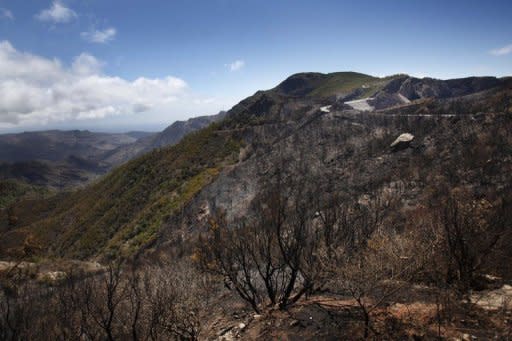Firefighters beat back Canary Islands blazes, Spain on alert
Firefighters made strides Tuesday against wildfires on Spain's Canary Islands that charred parts of a protected forest, but with a heatwave forecast the country was on alert for more blazes. A fire on the island of La Gomera has since Saturday affected over 3,000 hectares (7,400 acres), including 350 hectares or about 10 percent of the Garajonay national park, a World Heritage site. But thanks to lower temperatures and higher air humidity on Tuesday, "the work to put out the fire has produced good results," the regional government of the Canaries said Tuesday in a statement. Fog prevented the authorities from deploying water-dropping aircraft against the blaze on Tuesday morning but during the afternoon two helicopters and three planes were battling the flames. Another fire on neighbouring La Palma island near the town of Mazo was stabilised on Tuesday. That blaze had affected about 1,700 hectares. The Garajonay national park was added to UN cultural body UNESCO's World Heritage list for its rare subtropical forests, which covered the Mediterranean region millions of years ago but have now largely disappeared. It is home to 450 plant species, including eight found only in the park. "It will take 30 to 40 years for the parts of the park that burned to recover," said the environment secretary in La Gomera's government, Ventura del Carmen Rodriguez. "Firefighters have stopped the advance of the blaze on all its fronts," she added. Residents from Igualero, a village inside the park where several houses burned down, were allowed to return to their homes on Tuesday after being evacuated over the weekend. About 600 people in total were evacuated from their homes on La Gomera but they have now all been allowed to return. The wildfires have destroyed forest and farmland and killed dozens of sheep, goats and other animals. Spain has been battling fires both in the Canaries and on the mainland after a winter that saw almost no rainfall, leaving the Spanish landscape its driest in seven decades. Rainfall has continued to be scarce. In July, Spain received average precipitation of just 12 millimetres (half an inch) over the entire country, half the normal amount of 23 millimetres. Between January 1 and July 29, wildfires destroyed 130,830 hectares of vegetation in Spain, according to the agriculture ministry. Temperatures are expected to soar on Wednesday across almost all of Spain, increasing the risk of more wildfires. The national weather office issued a heat alert for 16 Spanish provinces, including Cordoba and Madrid, for Wednesday because temperatures there are expected to rise to around 40 degrees Celsius (104 degrees Fahrenheit). The interior ministry warned that there was a high risk of wildfires over the coming days because of the heat. It advised against throwing bottles in fields and forests or lighting campfires during the heatwave. "Negligence causes a high percentage of forest fires and major damage," the ministry said in a statement. On July 22, a wind-whipped wildfire in the northeast province of Catalonia near the border with France scorched 14,000 hectares, claiming four lives. Spain's most destructive fires so far this year were in the Valencia region in early July, burning some 50,000 hectares of vegetation.




